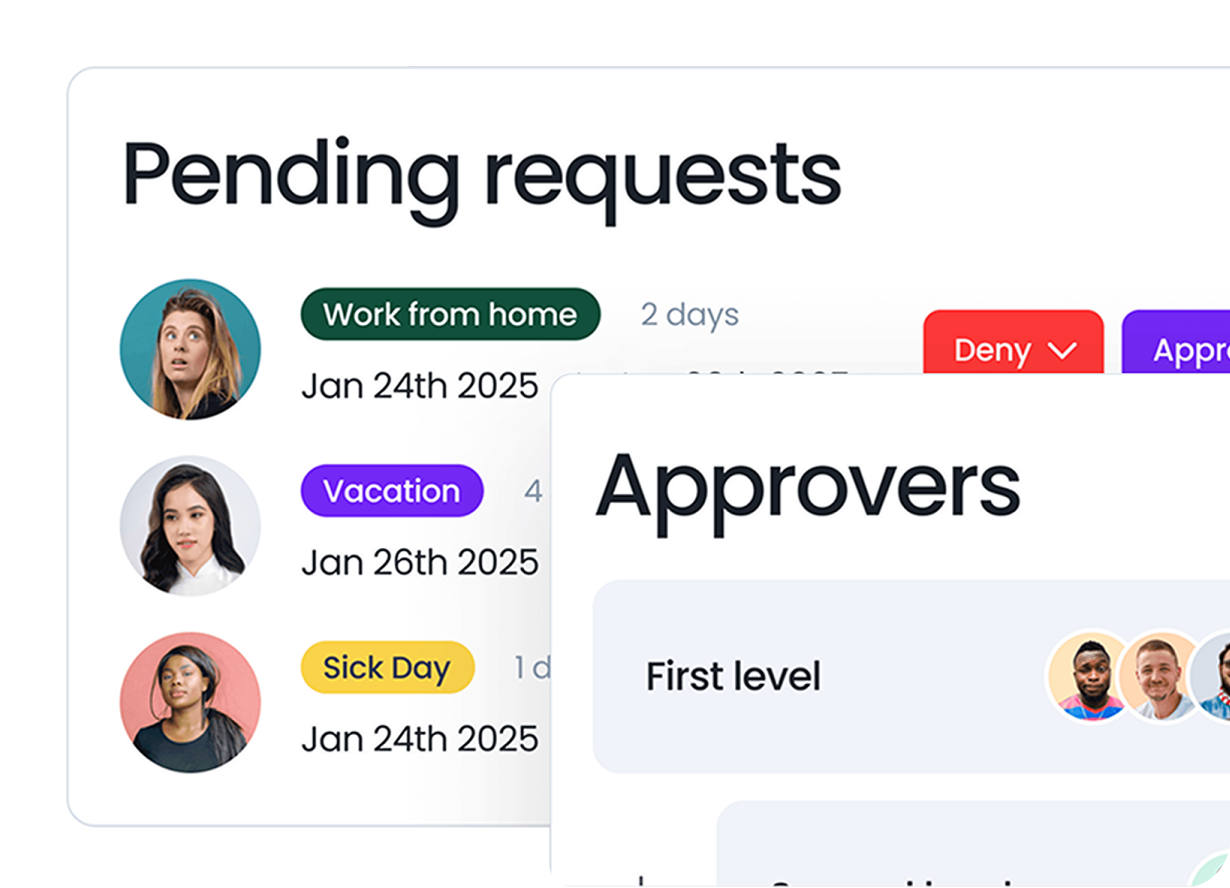Last updated on May 9, 2025
PTO benefits, or paid time off benefits, refer to any paid time employees can take away from work. This includes vacation days, sick leave, and additional perks that support employees’ time off. These benefits are increasingly seen as a core part of a competitive compensation package, right up there with salary and health coverage.
Companies use PTO benefits not just to offer rest, but to reduce burnout, encourage work-life balance, and give employees real reasons to stay. According to Gallup’s 2024 State of the Workforce report, 72% of employees say PTO is a major factor when evaluating job offers. In short, the right benefits don’t just support employee well-being; they directly impact hiring and retention.
If you’re updating your benefits or looking for ideas that go beyond the usual vacation days, this guide offers five PTO benefit examples that reflect what employees actually want, and use.
5 Innovative PTO Benefits
1. Employee Vacation and Travel Stipends
A travel stipend for employees, sometimes referred to as a vacation stipend or travel reimbursement, is a designated amount of money set aside for workers to use at their discretion within each calendar year.
This fund is intended to cover personal travel expenses, providing employees with the flexibility to use it for various travel-related needs. It gives employees the financial support they need to plan real time away from work, without dipping into savings.
Unlike business travel reimbursements, these stipends are specifically meant to support employees’ personal time off. They can be used for a weekend getaway, a flight home to visit family, or anything in between.
When paired with a strong PTO policy, a travel stipend helps employees take full advantage of their time off by reducing financial friction. It’s not just about encouraging rest, it’s about making time off more accessible and rewarding.
Examples:
- Airbnb: Offers employees a $2,000 annual stipend to use for an Airbnb stay anywhere in the world.
- BambooHR: Keeping it simple yet generous, BambooHR offers a $2,000 annual stipend for employees to use on their well-deserved vacations.
- Moz: Moz believes in the power of a good vacation, offering both U.S. and Canadian employees $3,000 a year to spend on their dream getaway.
2. Exclusive Employee Discount Programs
Another PTO benefit gaining traction is access to exclusive discounts that help employees save on leisure activities, travel, and wellness experiences. These aren’t just random promo codes, they’re curated offers employees can actually use.
You can partner with local entertainment providers, hotels, airlines, or wellness brands to offer discounts that make time off more enjoyable. Some companies even create internal marketplaces or portals with verified deals for employees to browse.
Think discounted flights, hotel bookings, spa packages, concert tickets, or restaurant vouchers. It’s a small but practical way to encourage employees to use their PTO, and enjoy it.
Beyond the savings, these programs send a clear message: your organization supports time away from work and wants to make it count.
3. Incentivized PTO
Incentivized PTO provides a financial reward when employees take extended time off. It’s designed to encourage rest by offering something extra beyond the time itself.
This addresses a common issue: employees accumulate time off but don’t use it.
This is a serious problem with US employees only taking on average 67% of their time off. Offering a clear incentive removes hesitation and reinforces that your company takes time off seriously.
According to the Society for Human Resource Management, many companies use PTO as a strategy to mitigate burnout. But without specific policies that encourage employees to actually take that time, PTO often goes unused.
That’s where incentives can make a real difference. By rewarding people for taking uninterrupted breaks, you’re helping shift workplace norms around rest and recovery.
For example, Evernote offers employees a $1,000 bonus for taking five consecutive days off. It’s not tied to receipts or travel plans, it's a thank-you for taking a real break.
Whether it’s a bonus, a small reward, or a public recognition program, incentivized PTO helps reinforce a healthy culture where taking time away from work is expected, not discouraged.
4. Buy and Sell Vacation Programs
Buy/sell programs are a flexible PTO benefit that lets employees adjust their time off to better suit their needs.
Employees can either:
- Purchase additional vacation days, or
- Sell unused days back for cash
These programs move away from rigid, use-it-or-lose-it policies and instead give employees a way to tailor PTO to their lifestyle or personal obligations.
Companies like KPMG have offered this benefit for years, and it continues to be one of the most employee-friendly approaches to managing PTO.
The appeal is straightforward. Some people want more time off, others want more money. This gives them the option to choose, without creating extra complexity for HR.
If your current leave tracking setup doesn’t support this level of flexibility, a tool like Vacation Tracker can help. You can create custom leave types, assign quotas, and give team leads visibility into balances, without adding to your admin load.
Want to see it in action? Book a personalized demo.
Learn how to manage time off without
Tracking Can Be
confusion, delays, or admin headaches. 
5. Sabbatical Programs
A sabbatical is a longer, planned break, usually several weeks or months, available after an employee has been with the company for a certain period (often 3, 5, or 7 years). While less common than traditional PTO benefits, sabbaticals are becoming more popular, especially in industries where burnout is high.
Some companies offer paid sabbaticals, while others keep them unpaid but hold the employee’s position during their time away. Either way, it’s a meaningful way to recognize long-term contributions and give people time to reset.
During a sabbatical, employees typically take a hiatus from their regular work responsibilities to pursue personal development, recharge, or engage in activities that contribute to their overall well-being. This time away is not only seen as a chance for rest but also as an opportunity for learning, reflection, and personal growth.
Structured properly, a sabbatical policy can:
- Improve long-term retention
- Reduce burnout in high-pressure roles
- Help employees return with new ideas, skills, and motivation
Just make sure the process for requesting and planning a sabbatical is clear, especially if you’re offering it as part of your official PTO policy.
Why PTO Employee Benefits Matter
PTO benefits create a work culture that people want to be part of.
Modern employees expect flexibility and value time off just as much as salary. When companies treat PTO as a meaningful benefit instead of an afterthought, the results are tangible: higher satisfaction, lower turnover, and better overall performance.
The key is to think about what will actually support your team. Not every benefit needs to be expensive, but it does need to be intentional.
Support Your New PTO Benefits with Automated Vacation Tracking
Adding new PTO benefits, like travel stipends, sabbaticals, or bonus-based time off, sends a clear message: you support your team’s well-being. And when you incentivize time off, people actually take it. That’s a good thing for morale, mental health, and retention.
But it can be an operational challenge because more time off means more to track.
As policies grow more flexible and usage increases, the risk of miscommunication or manual errors grows too. Without a clear system in place, things fall through the cracks. Enter overlapping absences, unclear leave balances, forgotten approvals, and inconsistent rules between departments.
That’s where Vacation Tracker comes in.
![]()
We built Vacation Tracker to help HR teams manage growing leave policies without getting buried in back-and-forth approvals or confusing spreadsheets.
With our tool, you can:
- Set up custom leave types like “Sabbatical,” “Bonus PTO,” or “Volunteer Day”
- Assign leave quotas by location, role, or seniority
- See who’s off at a glance with shared calendars
- Keep policies consistent and visible across your team
- Let employees request time off directly from Slack, Microsoft Teams, or Google Workspace
The result? You can offer innovative PTO benefits without worrying about how to track them.

Claudia
Claudia is an experienced marketer with a passion for writing and creating engaging content that connects with readers.




